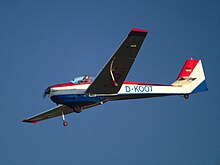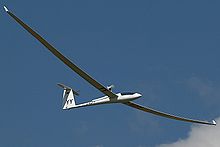Stretching (wing)
The aspect ratio is a dimensionless number for the slimness of a wing . It is defined as the ratio of the square of the wingspan to the wing area or alternatively as the ratio of the wingspan to the mean wing depth ( aspect ratio ):
With
- : Wingspan
- : Wing area
- : mean wing depth
In general, a value of Λ = 3 to 4 for low aspect ratio (paraglider), Λ = 5 to 6 for medium aspect ratio (flexible hang glider) and Λ > 20 (glider) is considered to be a high aspect ratio. General aviation aircraft usually have an aspect ratio of between 8 and 10. Very low values Λ <3, on the other hand, are used for the transonic and supersonic range as well as extremely low aspect ratios for circular wing aircraft and similar aircraft .
A high aspect ratio of the airfoil by reducing the end vertebrae caused induced drag . Extremely slim wings, however, cause problems with the mechanical stability of the wing and with the maneuverability of the aircraft. Winglets have a stretch-increasing influence and thus reduce the induced drag. If the span of a wing - and thus its extension - is allowed to go towards “infinity”, the effects of the finite wing disappear and there is a purely two-dimensional air flow around the profile.
The stretching of a wing is important in the subsonic area and in aircraft that are operated with a high coefficient of lift . In high-speed flight with low lift coefficients, the advantages of high aspect ratio are less, since the induced drag is directly linked to the lift coefficient. In flightless flight (nosedive) the induced drag tends to zero, while in slow flight it makes up the major part of the total drag.
In the supersonic , the flow conditions change fundamentally, which is why a high aspect ratio is dispensed with and the aerodynamic characteristics of a wing can be almost completely decoupled from the Mach number . The two Lockheed constructions F-104 and U-2 , which were created almost simultaneously in 1955/56, clearly show the differences in aspect ratio, as selected for the different requirements (supersonic vs. long-haul flight at very high altitude).
Another example of a low aspect ratio wing is the delta wing . The two examples show delta wings in which completely normal flow conditions Delta 1 - (elongation 7.21) or lift generation by cone vortex Handley Page HP.115 (elongation 0.9) prevail. A certain type of subsonic aircraft were designed with extremely low aspect ratio for other reasons (see aircraft extremely low aspect ratio ).
Slender wings with high aspect ratio can be found in z. B. in gliders , but also in high-altitude research aircraft , and in the animal kingdom with sailors such as albatrosses and gulls . Birds that tend to move by flapping their wings, on the other hand, have a lower aspect ratio, e.g. B. ravens and crows . Land raptors also usually have a smaller elongation than the sea birds mentioned.
Birds can of course adapt their wing geometry to the conditions in flight. Technical implementations can e.g. B. be wing flaps that change the wing depth (z. B. Akaflieg Braunschweig SB11), but also swivel wings (z. B. MRCA Tornado ) or telescopic changes in the wingspan such. B. the FS29 of Akaflieg Stuttgart, where the span can be varied between 13.3 and 19 m and thus the aspect ratio between 20.67 and 28.54. The highest stretches achieved so far include those of the Eta glider (51.33) and the Grob Strato 2C (22.02) powered airplane . In stark contrast, the 0.9 for the HP.115 and the 1.3 for the Chance Vought V-173 .
Despite its rectangular wing, the AeroVironment Helios solar aircraft has an aspect ratio of 30.88, and the Musculair II muscle-powered aircraft over 32.5.
Examples
| Model | span | Wing area | Elongation |
|---|---|---|---|
| Jet planes | |||
| Handley Page HP.115 | 6.10 m | 39.95 m² | 0.93 |
| Dassault Mirage III | 8.82 m | 34.80 m² | 1.94 |
| F-104 starfighter | 6.68 m | 18.22 m² | 2.45 |
| F-16 | 9.45 m | 27.87 m² | 3.20 |
| Boeing 737 MAX | 35.92 m | 124.60 m² | 10.36 |
| Lockheed U-2 | 31.40 m | 92.90 m² | 10.61 |
| Propeller planes | |||
| Supermarine Spitfire | 11.23 m | 22.48 m² | 5.61 |
| Piper PA-18 | 10.73 m | 16.58 m² | 6.94 |
| Cessna 172 | 10.97 m | 16.17 m² | 7.44 |
| DHC-2 "Beaver" | 14.63 m | 23.2 m² | 9.22 |
| Short 330 | 22.76 m | 42.08 m² | 12.3 |
| Washer SF 25 C | 15.30 m | 18.20 m² | 12.86 |
| Coarse Strato 2 | 56.50 m | 145.00 m² | 22.02 |
| Coarse G 520 | 33.0 m | 39.67 m² | 27.5 |
| Gliders | |||
| Schleicher Ka 6 | 15.00 m | 16.17 m² | 13.91 |
| Roller shutter cutter LS4 | 15.00 m | 10.50 m² | 21.43 |
| Hoarding H VI | 24.40 m | 17.40 m² | 34.22 |
| Schleicher ASH 25 | 25.00 m | 16.31 m² | 38.32 |
| Eta / Nimeta | 30.90 m | 18.60 m² | 51.33 |
| Concordia | 28 m | 13.7 m² | 57.2 |
| Akaflieg Darmstadt D-30 | 20.10 m | 12.0 m² m² | 33.6 |
| Muscle power aircraft | |||
| Musculair II | 19.50 m | 11.70 m² | 32.50 |
| Gossamer Albatross | 29.8 m | 45.34 m² | 19.6 |
| Daedalus 88 | 34 m | 29.98 m² | 38.5 |
| Solar planes | |||
| AeroVironment Helios | 75.30 m | 183.88 m² | 30.88 |
| Icaré II | 25th | 25 m² | 25th |
See also
literature
- Ernst Götsch: Aircraft technology . Motorbuchverlag, Stuttgart 2003, ISBN 3-613-02006-8 .












